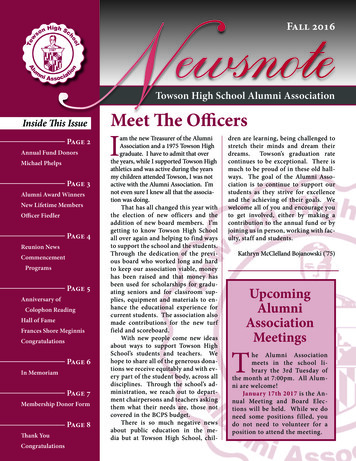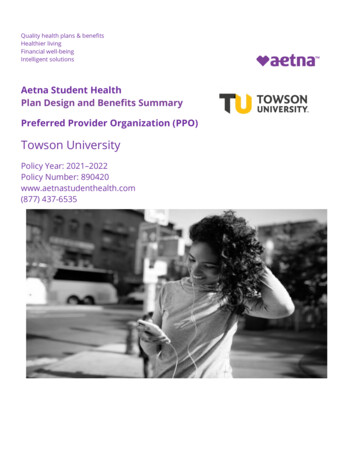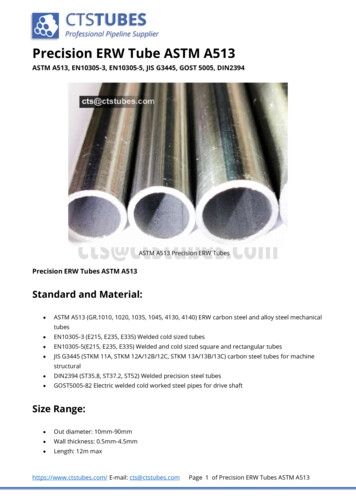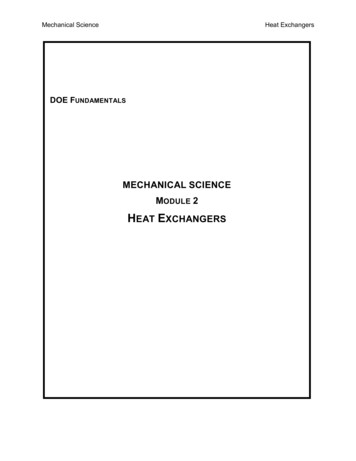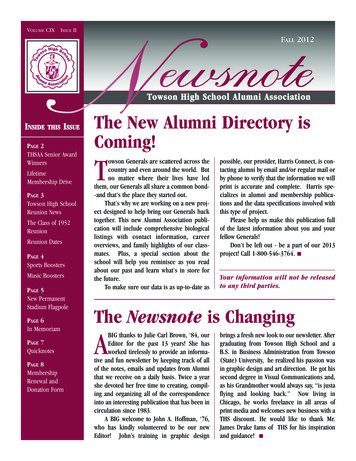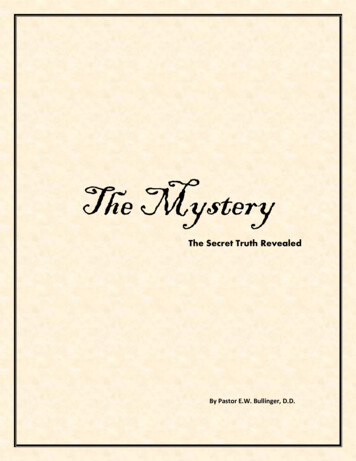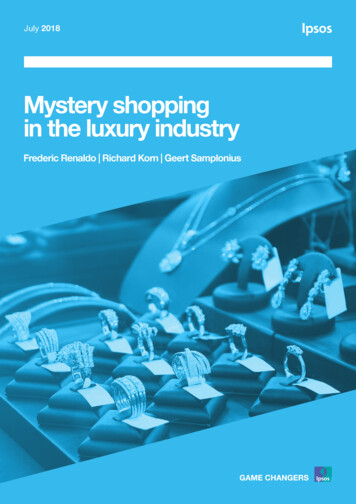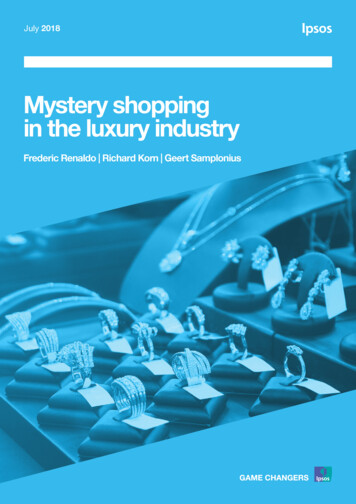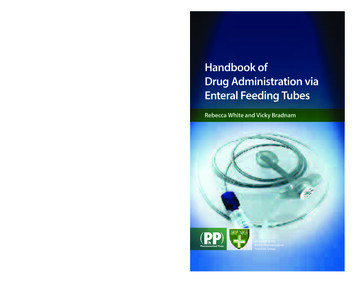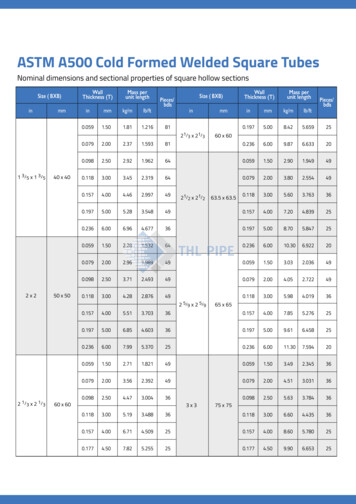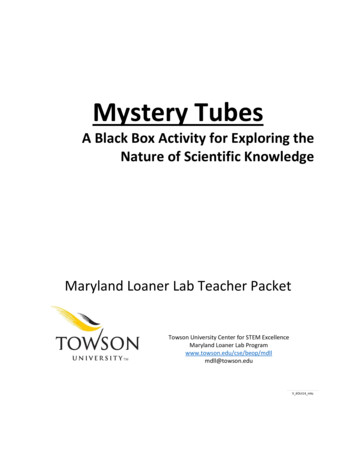
Transcription
Mystery TubesA Black Box Activity for Exploring theNature of Scientific KnowledgeMaryland Loaner Lab Teacher PacketTowson University Center for STEM ExcellenceMaryland Loaner Lab V 6Oct14 mks
Table of ContentsMystery Tubes Loaner Lab Overview. 2Maryland Standards . 3Next Generation Science Standards . 5Grade Level and Time Required . 6Equipment and Supplies . 6Teacher Introduction to the Mystery Tubes Activity . 6Resources . 9Nature of Scientific Knowledge . 9Models and Modeling in the Science Classroom . 9Preparation Before Class Begins . 10Mystery Tube Activity Facilitation Guide . 10Wrap-up and Assessment . 13Student Worksheet Answers: Mystery Tube Reflection Questions . 14Student Worksheet: . S-11 Page
Mystery Tubes Loaner Lab OverviewThe Mystery Tubes Loaner Lab is designed to give students an opportunity to explore some ofthe characteristics of scientific knowledge. Students who participate in the Mystery Tubesactivity will be actively engaged in the same scientific and engineering practices that scientistsuse every day. The Mystery Tubes activity is a way to explicitly address how scientists work andhow scientific knowledge is developed. An understanding of these processes is necessary forstudents to become scientifically literate and is an important instructional goal in both currentMaryland science standards, as well as the newly adopted Next Generation Science Standards.The goals of the Mystery Tube activity include understanding: how scientists construct explanations for phenomena they cannot see directlythat science is empirical and that data and evidence are what allow scientists to beconfident in their understandings and explanationshow scientific knowledge is tentative, yet durablehow and why scientists develop and use modelsThis version of the Mystery Tube activity was adapted from a previous version found inTeaching about Evolution and the Nature of Science (1998), pp 22-25, published by the NationalAcademy of Sciences.2 Page
Maryland StandardsTable 1 lists the standards from the Maryland State Curriculum for Grades 6-8 covered in the Black BoxMaryland Loaner Lab activity.Table 1. Standard 1.0 Skills and Processes for grades .1.fD.3.aD.3.bD.3.cExplain that scientists differ greatly in what phenomena they study and how they go about theirwork.Verify the idea that there is no fixed set of steps all scientists follow, scientific investigationsusually involve the collection of relevant evidence, the use of logical reasoning, and theapplication of imagination in devising hypotheses and explanations to make sense of thecollected evidence.Explain that what people expect to observe often affects what they actually do observe andthat scientists know about this danger to objectivity and take steps to try to avoid it whendesigning investigations and examining data.Explain that even though different explanations are given for the same evidence, it is not alwayspossible to tell which one is correct.Describe the reasoning that lead to the interpretation of data and conclusions drawn.Question claims based on vague statements or on statements made by people outside theirarea of expertise.Give examples of how scientific knowledge is subject to modification as new informationchallenges prevailing theories and as a new theory leads to looking at old observations in a newway.Criticize the reasoning in arguments in which Fact and opinion are intermingled. Conclusions do not follow logically from the evidence given. Existence of control groups and the relationship to experimental groups is not made obvious. Samples are too small, biased, or not representative.Explain how different models can be used to represent the same thing. What kind of a modelto use and how complex it should be depend on its purpose. Choosing a useful model is one ofthe instances in which intuition and creativity come into play in science, mathematics, andengineeringParticipate in group discussions on scientific topics by restating or summarizing accurately whatothers have said, asking for clarification or elaboration, and expressing alternative positions.Explain that the kind of model to use and how complex it should be depends on its purposeand that it is possible to have different models used to represent the same thing.Explain, using examples that models are often used to think about processes that happen tooslowly, too quickly, or on too small a scale to observe directly, or that are too vast to be changeddeliberately, or that are potentially dangerous.Explain that models may sometimes mislead by suggesting characteristics that are not reallyshared with what is being modeled.3 Page
Table 2 lists the standards from the Maryland State Curriculum for Grades 9-12 covered in theBlack Box Maryland Loaner Lab activity.Table 2. Goal 1.0 Skills and Processes for Grades 9-121.1.2 The student will modify or affirm scientific ideas according to accumulated evidence.1.1.3The student will critique arguments that are based on faulty, misleading data or on theincomplete use of numbers.1.1.5The student will explain factors that produce biased data (incomplete data, using datainappropriately, conflicts of interest, etc.)1.2.3 The student will formulate a working hypothesis.1.2.4 The student will test a working hypothesis. (NTB)1.4.2 The student will analyze data to make predictions, decisions, or draw conclusions.1.4.8 The student will use models and computer simulations to extend his/herunderstanding of scientific concepts.1.4.9 The student will use analyzed data to confirm, modify, or reject a hypothesis.1.5.1 The student will demonstrate the ability to summarize data(measurements/observations).1.5.2 The student will explain scientific concepts and processes through drawing, writing,and/or oral communication.1.5.4The student will use tables, graphs and displays to support arguments and claims inboth written and oral communication.1.5.5 The student will create and/or interpret graphics. (scale drawings, photographs, digitalimages, field of view, etc.)4 Page
Next Generation Science StandardsTable 3 details how the Black Box Maryland Loaner Lab activity is aligned with and supports theNext Generation Science Standards.Table 3. Next Generation Science StandardsScientific and EngineeringPractices Asking Questions and defining problemsDeveloping and using modelsPlanning and carrying out investigationsAnalyzing and Interpreting dataConstructing Explanations and DesigningSolutions Engaging in Argument From Evidence Obtaining, Evaluating, and CommunicatingInformationDisciplinary CoreIdeas This is a decontextualizedBlack Box activity, which bydefinition does not addressdisciplinary core ideasdirectly. Rather, it focusesstudents’ attention on howscientific knowledge isdeveloped (see Dimensions1 and 2).CrosscuttingConcepts Patterns Cause and effect:Mechanisms andexplanations Systems andsystem models Structure andfunctionNature of Science: Scientific investigations use a variety of methods Scientific knowledge is based on empirical evidence Scientific knowledge is open to revision in light of new evidence Science models, laws, mechanisms, and theories explain natural phenomena Science is way of knowing Science is a human endeavorConnections to Engineering, Technology, and Applications of Science:Not applicable.Connections to Common Core State Standards in Math and English Language L.3CCSS.ELA-Literacy.CCRA.SL.6Math:Not applicablePerformance Expectations:This activity will serve to support students as they engage in Performance Expectations that utilize thefollowing scientific and engineering practices: Asking questions and defining problems Developing and using models Planning and carrying out investigations Analyzing and interpreting data Constructing explanations and designing solutions Engaging in argument from evidence Obtaining, evaluating, and communicating information5 Page
Grade Level and Time Required Appropriate for grades 6-12 45 – 90 minutes required to complete activityEquipment and SuppliesTable 4. Materials supplied by the Maryland Loaner Lab ProgramDescriptionQuantityMust be Returned?Mystery Tubes10Return. Do NOT open Mystery Tubes.Cardboard Rolls15NoString1 ballReturn any unused portion.White Boards10Return. Please wipe clean.Dry-erase Markers10ReturnScissors10ReturnTable 5. Materials supplied by the TeacherDescriptionQuantityCommentsCopy of Student Worksheet1 perstudent2-page student handout provided.Pages S-1 and S-2 in this binder.Teacher Introduction to the Mystery Tubes ActivityWhen focusing heavily on content and memorizing definitions in science class, studentscan come to view science as a static collection of facts with nothing new left to learn. ‘BlackBox’ activities can be used in science education to engage students in learning about the natureof scientific knowledge, allowing them to see science as it really is - a dynamic enterprise, filledwith diverse, creative people all working toward a greater understanding of how the worldaround us works.Black Box activities are so named because they mimic a scientist’s search for anexplanation for a natural phenomenon that they cannot see directly, either because it is toosmall, too large, or otherwise inaccessible to their senses. A few examples include figuring outthe structure of the atom, determining what the center of the earth is made of, or6 Page
understanding how chemical reactions take place. In these cases, scientists must rely onindirect evidence that they can gather with their senses or extensions of their senses (such asmicroscopes).An important aspect of science, and one that is highlighted by Black Boxactivities, is that scientists cannot ‘check their answer’. There is no back ofthe book in science, no authority figure ‘grading’ answers. But if that is thecase, how do scientists know when they are on the right track? How can weever be certain about something if we cannot see it (or otherwise sense it)directly? Does this mean that scientists can never be confident of their understandings andexplanations? No! While it is true that scientists cannot directly observe every phenomena,the empirical nature of scientific knowledge requires that there be evidence that support theirconclusions. In cases where scientists cannot directly observe (or otherwise sense) aphenomena, they can, and do, rely on indirect evidence.Take Ernest Rutherford’s Gold Foil experiment, developed to explore the structure of anatom. While Rutherford was not able to directly observe the inside of an atom, his cleverexperiment allowed him to infer the existence of a nucleus by observing the pathways of smallalpha particles as they were directed at a thin film of gold. Using indirect evidence (flashes oflight on photographic film indicating the pathways of these alpha particles), he inferred thatsome of these particles did not pass directly through the gold foil, but rather were deflected.This observation led him to propose the new idea that there was a ‘charge concentration’ at thecenter of the atom, what we now call the nucleus. After coming to this conclusion, Rutherfordcould not simply check to see if he had the right answer. Instead, he shared his findings withthe scientific community, where additional evidence could be gathered and his idea couldcontinue to be tested.Scientists use evidence as a measure of ‘correctness’. As new evidence arises, it isexamined in the context of current explanations. The more evidence in support of an idea, themore certain scientists are in their conclusions. If evidence contradicts or otherwise does notsupport an idea, that idea is open to revision. The idea that scientific ideas are tentative (opento revision in light of contradictory evidence), yet durable (due to the weight of supportingevidence) is a great strength of science and an important concept for students to explore andunderstand.Sometimes in science there is more than one explanation that is supported by theevidence. In this case, scientists may disagree about which explanation is best. Many thingscan affect which explanation they may accept, including their previous scientific training. Manypeople find this surprising, as scientists are often described as objective. But science is ahuman endeavor, and as such cannot help but be affected by an individual’s own experience.While not all scientists will interpret data in exactly the same way, this does not mean that anyidea is acceptable in science. Scientists must be able to make a sound argument, backed up byevidence, as to why and how they have interpreted data to form their conclusions.7 Page
Developing and using models has been identified in A Framework for K-12Science Education (the foundational document upon which the NextGeneration Standards were developed) as one of the main Scientific andEngineering Practices. The Framework describes conceptual models as“explicit representations that are in some ways analogous to thephenomena they represent” and state that they “ allow scientists andengineers to better visualize and understand a phenomenon underinvestigation or develop a possible solution to a design problem” (p. 56).Examples of models include physical representations, mathematicalrepresentations, and computer simulations.Scientists use models in science for several reasons. They may use them to explain, orconvey information, such as in the case of a physical model depicting the earth’s core, the solarsystem, or a strand of DNA. This is likely the use of models that your students are most familiarwith, and have the most practice using.But scientists also use models for another purpose: to make and test predictions. Forexample, scientists may create a computer model to make predictions about what the weatherwill be like next week, or what the climate was like in the past. Ernest Rutherford created abasic atomic model that he used to test his predications about atomic structure in his famousGold Foil experiment. Geneticists use the model of inheritance developed by Gregor Mendel tomake and test predictions about allele frequencies. Using models in this way (to make and testpredictions) is likely something that your students are less familiar with, and have less practicedoing. In the Mystery Tube activity, students will create both a paper-and pencil model, as wellas build a physical model that will allow them to test their initial explanation of the innerworkings of a Mystery Tube.In this activity, the Black Box is a Mystery Tube. Students arechallenged to come up with a mechanistic explanation as to how the tubesare constructed, but they cannot see directly into the Mystery Tube. Oneway to develop an explanation of how the Mystery Tube works is to createand build a model of the Mystery Tube, which students can then use to testtheir proposed explanation of how the Mystery Tube is constructed. If themodel behaves in the same way the Mystery Tube behaves (i.e. you getidentical results when you perform identical actions on the model and theactual Mystery Tube) then their explanation is supported by the evidence. If their data do notsupport their proposed explanation, they can conclude that their proposed explanation of howthe tube is constructed is likely not accurate. Please note that we purposefully do not provideinformation as to how the Mystery Tubes are constructed, as one of the goals of this activity isfor students to explore and understand how scientists can be confident in their answers whenthey cannot check to see if they have the ‘right’ answer. Students (and teachers) should notopen the Mystery Tubes at any point during or after this challenge.8 Page
ResourcesFor more information on the nature of scientific knowledge and scientific modeling, check outthe following resources.Nature of Scientific KnowledgeUnderstanding Science WebsiteAvailable on line at: http://undsci.berkeley.edu/Evolution and the Nature of Science InstitutesAvailable online at: http://www.indiana.edu/ ensiweb/NSTA Position Statement on the Nature of ScienceAvailable online at: e.aspx and in‘Resources’ section of binder.Next Generation Science Standards, Appendix H: Understanding the Scientific Enterprise:The Nature of Science in the Next Generation Science StandardsAvailable online at nce-standards,click on Appendix H: Nature of Science and in ‘Resources’ section of binder.Models and Modeling in the Science Classroom“Engaging Students in Scientific Practices: What does constructing and revising models looklike in the science classroom? Understanding A Framework for K-12 Science Education”Available online at: http://nstahosted.org/pdfs/ngss/resources/201203 FrameworkKrajcikAndMerritt.pdf and in ‘Resources’ section of binder.Models and Modeling: An IntroductionAvailable online dels%20and%20Modeling%20An%20Introduction.pdf and in ‘Resources’ section of binder.“A Framework for K-12 Science Education: Practices, Crosscutting Concepts, and Core Ideas”Free pdf download available online at: http://www.nap.edu, type “A Framework for K12 Science Education” in search bar.9 Page
Preparation Before Class BeginsMaterial preparation before students arrive: Have a plan for placing students in 10 groups (2-4 students/group) Have a white board and dry-erase marker available for each group Have the following ready for each group to access when it comes time to make a physicalmodel of the Mystery Tube:o At least 1 paper roll per group (you have a few extra if groups need more thanone)o Pair of scissors for each group to cut pieces of stringo String One copy of the student worksheet “Mystery Tubes Student Worksheet” for each studentMystery Tube Activity Facilitation Guide Pass out Mystery Tubes to each group of students (2- 4 students per group). Tell the studentsto examine the Mystery Tube. Encourage them to pull on the strings and observe how theMystery Tube responds. Tell students they cannot open the Mystery Tubes. Next, ask the students to work together within their groups to explore and discuss how theythink the Mystery Tube works. That is, what does the internal construction of the MysteryTube look like? Have each student draw a model (diagram) on their student worksheet that depicts what theythink the inner workings of the Mystery Tube look like. The model should include any labels,arrows, descriptions, etc. necessary to clearly communicate the group’s ideas. Studentsshould be encouraged to share ideas within their groups, but it is not necessary that they allcome up with an identical model. At this point, ask your students how confident they are in their explanation for how the tubeworks. Ask them why they are, or are not, confident in their explanations. Some students willlikely say they are very confident, but will not have a good scientific reason why they areconfident. They may say because they “just know theirs is right” or that they “guessed” orthat “other people have the same explanation, so it must be right”. During this discussion, itis important to connect what the students are doing (looking for an explanation for how theMystery Tubes are built) to what scientists do (seek mechanistic explanations for naturalphenomenon). You can challenge students to think about what makes scientists confident intheir conclusions (the amount of data and evidence that support their explanations). After discussing how confident the students are in their models, ask them if there is anythingelse they can do that might increase their confidence in their current explanation. They may10 P a g e
come up with different ways (ask other people, look up information on the web, etc.). Askthem if they can think of any ways they could generate data to evaluate their model. Theidea you would like them to get to is that they can build a physical model of the Mystery Tubethat will allow them to test and see if it behaves similarly to the actual Mystery Tube. At this point, you will want to take advantage of the opportunity to explore with yourstudents how and why scientists use models (see Teacher Introduction and Resource sectionfor information on this topic). You can begin the discussion by asking students to think aboutand discuss the following questions:o What is a model in science?o How and why do scientists use models?o Can you think of at least three examples of models used by scientists?We suggest using a discussion technique that allows the students opportunities to thinkabout their own ideas, listen to and hear about their peers ideas, and encouragesdiscussion, questioning and debate amongst and between the students (not just with theteacher). Be prepared to help facilitate this discussion by asking probing questions, askingfor clarification and challenging them to think more deeply. See the ‘Discussion Techniques’section of the binder for a variety of discussion techniques you may choose to use. After students have had a chance to explore the role of models in science, provide studentsmaterials to build a physical model they can use to test if their proposed explanation for theinner construction of the Mystery Tube behaves in the same way as their actual MysteryTube. We have provided basic materials, including paper rolls, string and scissors. You maychoose to allow the students to use other materials (e.g. tape, washers, paper clips, etc.) butthey should be able to design a functional model with the basic materials provided.Encourage them to work as a group and share and discuss ideas as they work to build theirmodel to test their explanation. After groups have had time to build their model and test (maybe re-test if they madechanges) their explanations, ask them to draw any changes or refinements they made to theiroriginal diagram on their student worksheet. Again, it is important to keep connecting thisactivity to science and how science works, so you might ask them if, how and why scientistsmight change their models. For example, scientists may change or alter a model if there isnew relevant information, or if their tests did not accurately predict how the phenomenonbeing modeled behaved. Sometimes a group will very quickly build and test a model and say they are done. Challengethem by asking if their model is the only model consistent with the actual Mystery Tube. Havethem come up with, and test, alternative models to see if there may be more than onepossible explanation. Connect this to science by asking them to consider and discuss how11 P a g e
scientists consider multiple explanations for the same phenomena. Once all groups have had sufficient time to design, test, (re-design and re-test if necessary),pair two groups together and have them present and defend their explanation to each other,using the physical models they created as evidence for their explanations. Finally, have each group share their final model that depicts how they think the Mystery Tubeis constructed by drawing their final model on the group white board and displayingsomewhere where everyone in the class can view it. It is very likely that there will be differingexplanations as to how the Mystery Tube is actually constructed. If there are (and even ifthere are not), this is an excellent opportunity to ask the students which one is “right”. Thiswill likely lead into a lively discussion, often with students wanting to open the Mystery Tubesto see what the right answer is (which they cannot do!). The goal is to facilitate thediscussion to cover the following points:o How do scientists know when an explanation is “right”? Can scientists ‘open the tube’or go to the back of the book to check their answers? Scientists cannot ‘check’ their answers in the same sense that many studentsare able to do when they complete a homework assignment or get graded on atest. In science, “correct” answers are determined by how well the data andevidence support or explain the phenomena. More supporting evidence lendmore weight and more confidence to an explanation. Evidence thatcontradicts, or does not support an explanation can lead to an idea orexplanation being rejected. Scientists seek confirmation from multiple lines ofevidence when evaluating an explanation or idea. At this point, many of your students may become frustrated that they are notallowed to open the Mystery Tubes. This is very common, and can serve as apowerful teachable moment. So many activities that students do in scienceclass have a ‘right’ answer and this can lead to a naïve view that there is asingle correct answer in science. It also can leave students feeling that there islittle room for creativity and new ideas in science, a naïve view that may lead toa lack of interest in pursuing science as a field of study or possible career path.o How do scientists evaluate differing explanations for the same phenomena? In otherwords, what if there are multiple explanations that are supported by evidence? Forexample, in the case of the Mystery Tubes, what happened in class if there were twodifferent explanations, supported by evidence generated from the physical models asto how they were constructed?12 P a g e
Scientists evaluate the data, evidence and reasoning provided for eachexplanation and choose the explanation they feel provides the strongestargument. Sometimes, scientists may disagree about which explanation is thestrongest, as they may have different perspectives, or consider differentevidence and reasoning. Scientists may continue to disagree, or may changetheir mind and support a different explanation if new evidence (or new ways ofinterpreting the same evidence) are found. Scientists also often apply the ruleof parsimony when evaluating explanations and ideas. Parsimony is the ideathat a simple explanation is often accepted as more likely than a more complexexplanation.Wrap-up and AssessmentAsk students to complete the Mystery Tube Reflection Questions (page S - 2). This canbe done in class, or assigned as homework.Once students have had a chance to individually answer the questions, put the studentsin small groups (these can be different from the groups they worked with earlier in the activity).Ask the students to share and discuss their responses. See the ‘Discussion Techniques’ sectionof the binder for ideas to help facilitate and encourage discussion among the students.Collect the students written responses and use them to formatively assess yourstudents’ understanding of the nature of scientific knowledge. As with any concept you aretrying to teach, it is important to know your students current level of understanding. You mightnotice that despite having just engaged in the Mystery Tubes activity that is meant to conveyinformed ideas about the nature of scientific knowledge, your students still struggle to answerthese types of questions, or answer with naïve conceptions. Don’t be discouraged! Studentsneed lots of opportunities to think about these ideas and come to their own understanding. Aone-time discussion about the empirical nature of scientific knowledge or the role of models inscience is not going to be enough for students to really understand these concepts.Continue to follow-up and circle back to these ideas about the nature of scientificknowledge throughout the school year. Whenever possible, introduce real-life scienceexamples that illustrate some of these ideas. For example, popular news will often have storiesof new discoveries in science that were unexpected or contradicted previous findings. Thesestories provide excellent opportunities for students to explore the idea that science it istentative (but durable). The next time students are using models (in another assignment or labactivity), ask them to reflect on how they are using models and how it is similar to whatscientists do. This will allow the students more opportunities to think not only about scientificcontent and ‘facts’ but also about the way in which this knowledge was developed.13 P a g e
Student Worksheet Answers: Mystery Tube Reflection Questions1. How do scientists know when they have a ‘right’ answer?Informed answers may include the following: Scientists rely on data and evidence. The strength of scientific explanations and arguments increase as the amount ofsupporting evidence increases. Multiple lines of evidence increase scientists’ confide
Mystery Tubes Loaner Lab Overview The Mystery Tubes Loaner Lab is designed to give students an opportunity to explore some of the characteristics of scientific knowledge. Students who participate in the Mystery Tubes activity will be actively engaged in the same scientific
